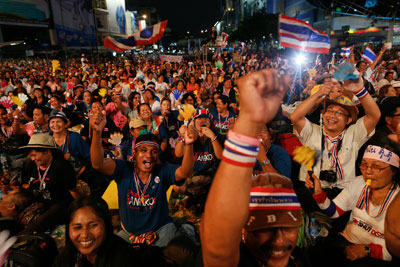For the past several weeks journalists and media organizations in Thailand have been preparing for a fresh round of confrontation between anti-government protesters and government security forces. An attempt to paralyze the nation’s capital through a protester-led, month-long shutdown began today.
Having covered previous political confrontations in Thailand, including attempts by the same group of protesters to storm Government House in November, and observed first-hand the savagery with which elements of People’s Democratic Reform Committee (PDRC) protest group have attacked security forces and intimidated and assaulted journalists, I have questioned with increasing urgency how to continue working safely.
While the basic rule of covering conflicts safely by not standing between opposing forces is inviolable, recent clashes in Bangkok have shown that the danger area is apt to change rapidly and with little or no warning. That was the case during the previous round of street protests by opposing groups in 2010, where two journalists were killed and several others seriously injured by gunfire originating mainly from areas controlled by the Royal Thai Army.
As a younger photojournalist working in areas of conflict, I tended to shy away from using body armor due to the physical strain of the added weight and decreased mobility. However, given the randomness in which firearms have been used by PDRC protesters in this conflict and by the Thai army in 2010, coupled with increasing age and slower mobility, I’ve determined that body armor is essential for my street-level reporting.
While there is an abundance of body armor available for purchase at various outlets in Bangkok, including from shops located behind the Ministry of Defense and at the Chatuchak Weekend Market, a perfunctory examination shows the items are sub-standard and ill-equipped to deflect gunfire.
Yet my attempts to import proper body armor has been thwarted by bureaucracy and labyrinthine import controls. The Thai Customs Department advised that I would first need to acquire import licenses from three separate government agencies, including two different Ministry of Defense departments. Thailand’s Arms Control Act stipulates that a permit is required to possess such items, with fines and imprisonment penalties for non-compliance.
Telephone calls and a visit to the Defense Energy Department showed that not only did officials not know how to proceed with my application, but that no media organization or individual in Thailand had ever applied for such a permit.
The officer in charge of processing permit applications was at a loss over how to proceed and it was only after several hours of discussion that a decision was reached that he would accept an application to forward to his superiors.
While the official expressed his understanding as to why I required the items as well as his hopes that my application would be approved, he and others tasked with processing my request also ventured their personal opinions that my application would most likely be denied.
The vast array of documents originally requested in support of my application included: A criminal background check of my media company’s director(s); A copy of the identification card/passport and home register of the company’s director(s) and attorney; the Power of Attorney of the company; and the Power of Attorney of where the items are to be stored. Under Thailand’s Arms Control Act there is no difference between importing and possessing a Kevlar helmet and importing and possessing munitions.
Clearly the majority of these documents are not going to be available to most journalists, and with a criminal background check requiring about 45 days to process, my application is not going to be considered quickly. Letters I sent to Suranand Vejjajiva, secretary-general to the prime minister, and Deputy Prime Minister Phongthep Thepkanjana regarding the issue have so far gone unanswered.
Until allowances are made for the legal import and possession of body armor, Thai and foreign reporters will be forced to either break Thai law by possessing and wearing the items without a proper permit; play Russian roulette with costly items sent by mail, subject to seizure and forfeiture by the Thai Customs Department; or continue to be exposed to lethal threats while reporting.
